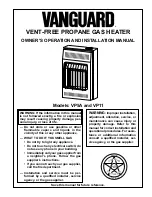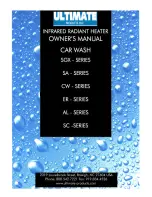
IO-123114 Effective 12-04-2014
9
Line voltage wiring should be routed through the access holes at the
side of the air handler. Proper electrical conduit connection fittings
should be used. Connect the power wiring to the line side connec-
tions on the air handler. The electrical ground wire should be con-
nected to the grounding lug. Ensure both the field supplied ground
wire and air handler GREEN ground wire are both secured to the
grounding lug of the air handler (Fig 11-2).
If the line voltage being supplied to the air handler is 208 volt single
phase, the line voltage tap on the low voltage transformer needs to
be moved from the 240 volt tap to the 208 volt tap. If this is not done,
the secondary output voltage of the transformer will be too low (Fig
11-3).
Fig 11-2.
Fig 11-3.
Final air volume adjustments should be made by referencing total
external static pressure (Table 11A-1).
Table 11A-1.
11A. Single Stage Cooling
During cooling mode operation, indoor blower wire “G” will energize
a time delay relay located on the control board inside the air han-
dler. After a short time delay period, the time delay relay will apply
240VAC to the motor via the “MTR“ terminal. (See Schematic Fig
20-1.) Fan time delay periods are 30 seconds ON delay and 120
seconds OFF delay.
The Y wire from the thermostat is not connected at the air handler.
This wire goes directly to the outdoor unit 24 volt wiring to turn on
the outdoor condensing unit when a call for cooling takes place. The
24 volt common for the outdoor unit circuitry is connected at the air
handler brown wire. (See Fig 11-1.)
The heater low voltage wiring terminal “W” is wired directly from the
thermostat to the air handler. The indoor blower, on a call for heat,
will ON delay for a period of 5 seconds. When the call for heat has
been satisfied, the indoor blower will have an OFF delay time period
of 60 seconds.
12. Condensate Drain
1. Select desired condensate drain openings according to air han-
dler orientation. Both Primary and Secondary outlets can be used.
2. Pipe condensate system using proper PVC fittings.
3. Ensure a minimum 2” trap is installed in the condensate drain. Lo-
cate the trap near to the connection opening on the air handler. See
illustration.
13. Air Volume Adjustment
Air volume needs to be set to the level recommended by the outdoor
unit equipment manufacturer. Most systems will require around 400
CFM of indoor air for every 1 ton of system cooling capacity. The air
volume must be set prior to attempting system charge.
This air handler uses a PSC type motor. The speed of this motor
is set by placing the appropriate winding lead wire on the “MTR”
terminal of the control board. Unused motor winding leads are to
be placed on the “BLANK” terminals on the control board. The air
volume level produced by the air handlers at varying external static
pressure levels is shown in Table 11A-1.
240VAC
Tap
208VAC
Tap
ELECTRIC HEAT KIT NOMENCLATURE
H
C
S
10
H = Fits GAS, GAT, GES*, GET*
Power Connection
C = Circuit Breaker
L = Large Cabinet (42 - 61)
S = Small Cabinet (18 - 36)
Heat Strip
00 = NO Heat
03 = 3 KW
05 = 5 KW
06 = 6 KW
08 = 8 KW
10 = 10 KW
BLOWER DATA
UNIT MODEL
RPM
AMP
VOLT
HP
CFM VS. STATIC PRESSURE
0.00
0.10
0.20
0.30
0.40
GAT 18
1625
1.4
240
1/4
850
775
700
675
600
GAT 24
1000
900
850
775
700
GAT 30
2.15
240
1/3
1200
1150
1100
1050
975
GAT 36
1600
1500
1400
1300
1200
HEATING AND COOLING PERFORMANCE & ELECTRICAL DATA
MODEL
HEAT KIT
PERFORMANCE DATA
ELECTRICAL DATA
NOMINAL
COOLING
(TONS)
HEATING
(KW)
HEATING
CAPACITY
(MBTUH)
MIN-CIRCUIT
AMPACITY
MAX FUSE OR
CIRCUIT
BREAKER
208V
204V
208V
204V
208V
204V
208V
204V
GAT 18
HCS00
1.5
0.0
0.0
0.0
0.0
1.9
2.3
15.0
15.0
HCS03
2.3
3.0
7.7
10.3
15.0
17.0
15.0
20.0
HCS05
3.8
5.0
13.0
17.1
24.0
29.0
30.0
30.0
HCS08
6.1
8.0
20.8
27.3
28.0
43.0
40.0
50.0
HCS10
7.6
10.0
25.9
34.1
47.0
54.0
50.0
60.0
GAT 24
HCS00
2.0
0.0
0.0
0.0
0.0
1.9
2.3
15.0
15.0
HCS03
2.3
3.0
7.7
10.3
15.0
17.0
15.0
20.0
HCS05
3.8
5.0
13.0
17.1
24.0
29.0
30.0
30.0
HCS08
6.1
8.0
20.8
27.3
28.0
43.0
40.0
50.0
HCS10
7.6
10.0
25.9
34.1
47.0
54.0
50.0
60.0
GAT 30
HCS00
2.5
0.0
0.0
0.0
0.0
2.0
3.0
15.0
15.0
HCS03
2.3
3.0
7.7
10.3
15.0
18.0
15.0
20.0
HCS05
3.8
5.0
13.0
17.1
25.0
29.0
30.0
30.0
HCS08
6.1
8.0
20.8
27.3
40.0
45.0
40.0
50.0
HCS10
7.6
10.0
25.9
34.1
49.0
55.0
50.0
60.0
GAT 36
HCS00
3.0
0.0
0.0
0.0
0.0
2.0
3.0
15.0
15.0
HCS03
2.3
3.0
7.7
10.3
15.0
18.0
15.0
20.0
HCS05
3.8
5.0
13.0
17.1
25.0
29.0
30.0
30.0
HCS08
6.1
8.0
20.8
27.3
40.0
45.0
40.0
50.0
HCS10
7.6
10.0
25.9
34.1
49.0
55.0
50.0
60.0
AIR HANDLER CHASSIS NOMENCLATURE
G
A
T
18
G
-001
AirMark
Air Handler
Voltage
A = 240V PSC Motor
B = 120V PSC Motor
Configuration
T = Cased Ceiling Mount
Nominal
Tonnage
(MBTUH)
Metering Device
4 = non-bleed A/C or H/P R410 TXV
6 = 20% bleed A/C or H/P R410 TXV
B = 20% bleed A/C or H/P R22 TXV
F = R-22 Flo-rater
G = R-410A Flo-rater
X = non-bleed A/C or H/P R22 TXV
Option Code
1.
Select a speed tap from the CFM table and connect appropriate
motor lead wire to the “MTR“ terminal on the control board.
2.
Call for fan only operation at the thermostat.
3.
Read the external static pressure level on the Magnehelic gauge.
4.
Make speed tap selection change to get the air volume as close
as possible to the required level.
5.
If the static pressure is above .5” wc, excessive turbu
-
lence or duct friction needs to be reduced. (Obstructions in
the duct system can also cause excessive static pressure.)
6.
When proper air volume is established, move on to the charging
procedure.
Use a Magnehelic Gauge with a 1” scale and two static pressure
tips to measure the static pressure during the air volume adjustment
procedure. The high port static pressure tip should be placed in the
supply duct near the outlet of the air handler. The low port static pres-
sure tip should be placed in the return air duct near the entrance to
the air handler.
Use a Magnehelic Gauge with a 1” scale and two static pressure
tips to measure the static pressure during the air volume adjustment
procedure. The high port static pressure tip should be placed in the
supply duct near the outlet of the air handler. The low port static
pressure tip should be placed in the return air duct near the entrance
to the air handler. The factory provided air filter should be in place
inside of the air handler.
COM
































